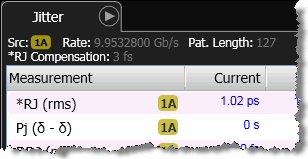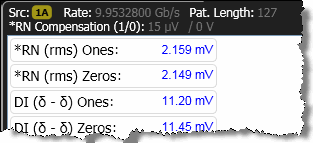Jitter Mode Setup (Advanced tab)
Advanced with RJ/RN Compensation
Use the Advanced tab of the Jitter Mode Measurements Setup dialog, to configure advanced jitter mode settings. In this picture, click on the Separation Method, Stabilization and RJ/RN Compensation tabs to learn more.

Probability/SER
Use to specify PAM4 jitter analysis to be based on probability or Symbol Error Ratio (SER). TJ, TI, eye width, and eye height measurements in the latest standards are made at probabilities instead of SER.
CRE Jitter Optimization

If JSA is available, the CRE Jitter Optimization field will be displayed. Select Enable CRE Jitter Optimization to apply clock-recovery emulation to Jitter Mode's RJ measurement. This feature is only available if JSA is turned on in Jitter mode and the JSA spectrum is set for Embedded. You can also apply jitter optimization by clicking the CRE Jitter Optimize button that is located on the JSA/CRE toolbar. Click the Setup CRE PLL button to configure the clock-recovery PLL emulation.
CRE Jitter Optimization is only available if an N1060A or 86108A/B Option JSA module is installed in the N1000A. Installing this module makes available Jitter Spectrum Analysis on FlexDCA.
Specify Pattern Symbol Sequence
Use this setting to specify the input waveform's pattern symbol sequence (NRZ or PAM4). As shown in the following picture, you can select to have the pattern automatically detected (default), select from a standard Known Pattern, or import a BERT Pattern File (*.ptrn). Available known patterns are listed in the following table. If you select to import a PAM4 Pattern File, you should indicate if the pattern uses Gray Coding. Gray coding, or reflected binary code, is a coding pattern where successive symbols differ by one binary bit. For example in the case of PAM4, binary bit sequences 00, 01,10, and 11 represent levels 0, 1, 2, and 3.
| Selection | Format | Command Argument |
Description | |
|---|---|---|---|---|
| NRZ | PAM4 | |||
| PRBS 7 (127 symbols) | ♦ | ♦ | PRBS7
|
27−1 pseudo-random symbol sequence (127 symbols). |
| PRBS 7 (128 symbols) | ♦ | ♦ | EPRBs7
|
27 pseudo-random symbol sequence (128 symbols). |
| PRBS 9 (511 symbols) | ♦ | ♦ | PRBS9
|
29−1 pseudo-random symbol sequence (511 symbols). |
| PRBS 9 (512 symbols) | ♦ | ♦ | EPRBs9
|
29 pseudo-random symbol sequence (512 symbols). |
| PRBS 11 (2047 symbols) | ♦ | ♦ | PRBS11
|
211−1 pseudo-random symbol sequence (2,047 symbols). |
| PRBS 11 (2048 symbols) | ♦ | ♦ | EPRBs11
|
211 pseudo-random symbol sequence (2,048 symbols). |
| PRBS 13 (8191 symbols) | ♦ | ♦ | PRBS13
|
213−1 pseudo-random symbol sequence (8,191 symbols). |
| PRBS 13 (8192 symbols) | ♦ | ♦ | EPRBs13
|
213 pseudo-random symbol sequence (8,192 symbols). |
| PRBS 15 (32767 symbols) | ♦ | ♦ | PRBS15
|
215−1 pseudo-random symbol sequence (32,767 symbols). |
| PRBS 15 (32768 symbols) | ♦ | ♦ | EPRBs15
|
215 pseudo-random symbol sequence (32,768 symbols). |
| Linearity (160 symbols) | ♦ | LPAM4
|
||
| K28.5 (20 symbols) | ♦ | K28P5
|
||
| PRBS9Q (511 symbols) | ♦ | PRBQ9
|
PRBS9Q (511 symbols). | |
| PRBS13Q (8191 symbols) | ♦ | PRBQ13
|
PRBS13Q (8,191 symbols). | |
| SSPR (32762 symbols) | ♦ | SSPR
|
||
| SSPRQ (65535 symbols) | ♦ | QSSPr
|
SSPRQ (65,535 symbols). | |
RJ/RN Compensation Tab
The section presents the RJ/RN settings. For additional information, refer to:
RJ Compensation
Use RJ Compensation, to specify a compensation value of RJ that you need applied to the measured result. In the drop-down list select either:
- OFF
- Remove Custom Jitter Value
In the measurement pane, an asterisk is shown next to the RJ (rms) measurement results warning you that the measurement result has been modified. Above the table the annotation RJ Compensation: lists the entered value.

Use this setting to remove intrinsic oscilloscope jitter from the measurement results. Every jitter measurement, whether performed on a scope, TIA, or BERT, includes a component of jitter that has been generated by the measurement instrument itself. This is often referred to as intrinsic jitter. The RJ result is an RSS sum of RJ from the instrument and Device Under Test (DUT):
RJ2meas = RJ2DUT + RJ2meas system
To determine the intrinsic RJ from your measurement system, measure the jitter of a source that is known to have extremely low phase noise, such as an Keysight E8267D PSG Analog Signal Generator. Alternatively, if you are using a BERT or pattern generator to drive the DUT, connect the BERT or pattern generator directly to the N1000A and measure jitter using a PRBS7 or 1010 pattern. The measured RJ is the intrinsic RJ of your measurement system. Enter this value into the RJ Compensation field and this random jitter contribution will be RSS'd out of the results.
For the 86108A, intrinsic jitter is very small and you need not use the RJ Compensation feature.
RN Compensation
Use RN Compensation, to specify a compensation value of RN that you need applied to the measured result. In the drop-down list select either:
- OFF
- Remove Scope Noise
- Remove Custom Noise Values
In the measurement panel an asterisk is shown next to the *RN (rms) measurement results warning you that the measurement result has been modified. Above the table the annotation RN Compensation: lists the entered value. Enter RN one/zero values in volts (electrical) or watts (optical), depending on the type of signal that you are measuring.

Use this setting to remove intrinsic oscilloscope noise from the measurement results. First, estimate the Random Noise that is contributed by the DCA-X by disconnecting all cables and signals from the oscilloscope's input and then measuring Vrms (AC) in Oscilloscope mode. Enter this value into the RN Compensation field, and its contribution to the RN measurement will be removed.
Click the tabs in the picture at the top of this topic to view information about the other Random Jitter/Interference (RJ/RN) features.